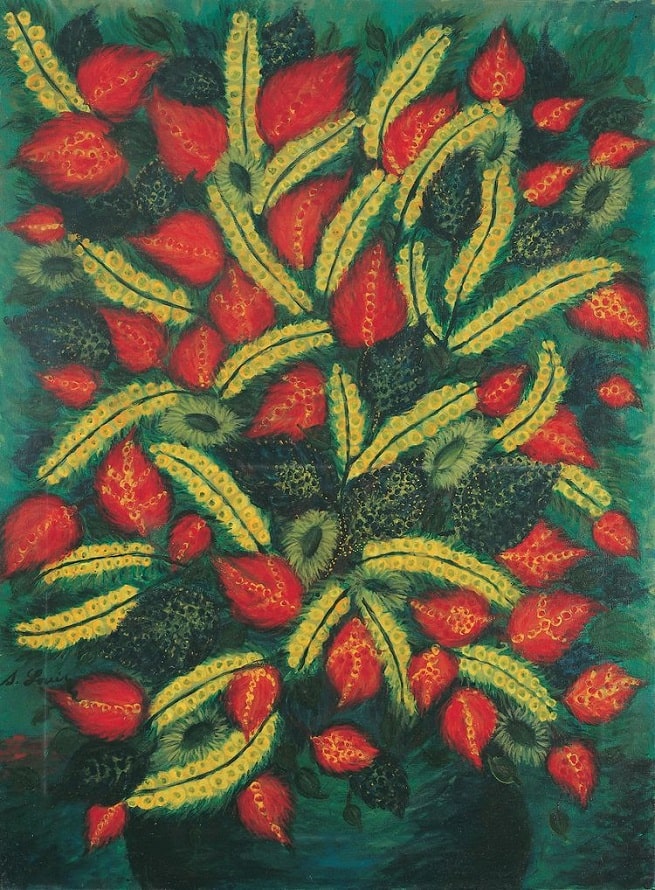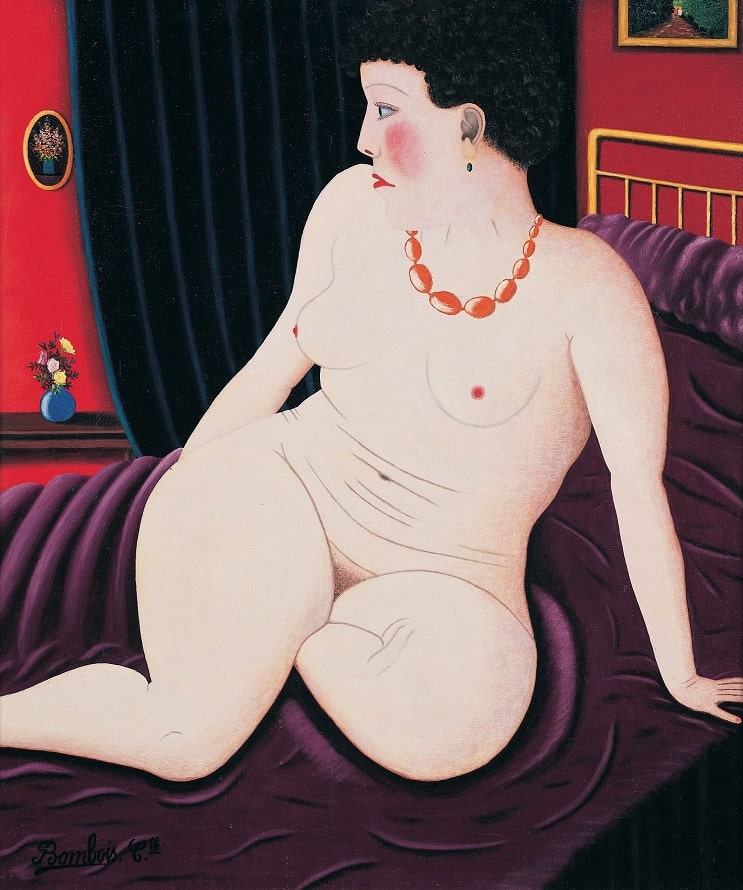(THE PAINTERS OF THE SACRED HEART)
The exhibition puts the work of the great French autodidacts of the early 20th century in a new light. From the big city to nature, its flowers, blossoms and fruits, from the temptations of a non-bourgeois life to mythological and religious scenes: Using selected works, mainly from the Charlotte Zander Collection (1930 – 2014), she opens up the cosmos of the life and fantasy worlds of these painters, who sought artistic pursuits alongside their bourgeois existence. Always in the background: the important German art historian Wilhelm Uhde (1874 in Friedeberg/Neumark – 1947 in Paris), whose criticism of the coldness of modernism found precisely in their work the unbroken authenticity he so passionately sought.
Image above: André Bauchant, Le triomphe de Neptune, 1929, Sammlung Zander © VG Bild-Kunst, Bonn 2022
With five important and diverse artistic personalities of his time, the exhibition reconstructs the circle around Wilhelm Uhde, who brought them together for the first time in his historic Paris exhibition “Painters of the Sacred Heart” of 1928. In this way, it pays tribute once again to the high aesthetic appeal and the immediacy of the effect of this painting, which was not “formed”.
Probably best known is the publican Henri Rousseau (1844-1910). His paintings often present a pristine, sometimes even exotic landscape in which animals rather than people reign and nature is still very much with itself in its original show of strength.
The painter and postman Louis Vivin (1861-1936) also takes us to idyllic landscapes and scenes of home life, to longingly transfigured city and nature scenes in which fauna and flora still form a harmonious whole.

The gardener André Bauchant (1873-1958) painted not only landscapes but also poetic-mythical visions. His art is characterised by his great passion for ancient mythology, with which he came into contact as a soldier in Greece during the First World War.
Séraphine Louis (1864-1942) is the only artist in this circle; as Wilhelm Uhde’s housekeeper she came into contact with him early on. Her colourful still lifes of flowers, blossoms and fruits already anticipate an abstract-ornamental understanding of the picture. During her life, she increasingly immersed herself in her increasingly suggestive ideas of nature-art.

Camille Bombois (1883-1970) is considered one of the better-known painters of the circle. In his early years, Bombois worked as a servant, helper and fairground wrestler – his pictorial worlds also evoke an immersion in the life of the bohemian world, the half-worlds of circus performers and “ladies-in-life”, and he likes to seek out the buxom and the drastic, staging lust and desire.
The five non-academically trained artists in this exhibition are still rather unknown in this country – with the exception of Henri Rousseau, who found powerful advocates early on – in their complex work. Over the decades, they have been categorised as “naïve” artists, as artists of an emerging modern primitivism and finally as so-called outsider artists. The current exhibition now attempts to place their work in a new context: that of an early modernist critique.
Wilhelm Uhde and his alienation from modernity
“I often had the opportunity to take art historians and museum officials to private collections, and I was soon able to observe with satisfaction that my personal passionate attachment to the individual object had led to an artistic understanding superior to theirs, which derived from knowledge and theories. It added that I remained a harmless lover in front of a painting, while for her it was an opportunity to satisfy her vanity through original cerebral acrobatics. Works of art were all too often occasions for them to prove their theories by streams of ink, to let their own minds shine.”
Wilhelm Uhde in his “Memories and Confessions” published in 1938
Wilhelm Uhde, who came from Germany and worked in Paris, was not only an important art historian and art dealer who was one of the first to exhibit the emerging greats of the 20th century such as Pablo Picasso and George Braque in their early days. He was also the decisive discoverer and promoter of the so-called “painters of the Sacred Heart”. Thus Uhde had sensed and recognised early on the fascination of the authentic works of these self-taught artists, which were not formalised by training and canon. He was looking for art that touched people’s hearts directly – far away from the canonisation that the art business with its directions and movements, its traditions, its academies and its mercantile interests was increasingly shaping.
Increasingly, he was disappointed by precisely this development that modernist art was taking with its increasingly sophisticated conceptual and analytical approaches and discourses – and in the process moving away from its original spiritual forces and emotional moments of experience. “The Painters of the Sacred Heart” took him back to a world of senses and feelings, of sincere passion for art and its immediate impact.

Uhde, who was at the same time an art dealer, gallery owner, author and passionate patron of artists, understood art, the work of art, as inseparable from the character of the creator. For him, art is based on “humanity”, which includes his own self-image. The great attraction of the group of artists he promoted was above all that they owed their painterly inspiration mainly to intuition, feeling and, Uhde continued, a “great heart”.
At this point, his thinking follows that of the French philosopher Jean-Jacques Rousseau, who, in his famous “Discourse on the Sciences and the Arts” as early as 1750, for the first time placed the feeling soul, i.e. what constitutes the human being, before Enlightenment reason and thus proclaimed innocence as a valuable social value. – The exhibition also pays special tribute to Uhde’s work in the form of a cabinet presentation.
Curator of the exhibition Udo Kittelmann on his consistent examination of so-called “outsider art”: “The exhibition “The Painters of the Sacred Heart” at the Museum Frieder Burda and the accompanying catalogue intend, on the one hand, to comprehensively honour the outstanding and unique pictorial inventions of their five creators and their unbroken topicality – and thus to give their personal visions a common and special place for the duration of the exhibition”. And further: “On the other hand, this artistic “liaison” is to be understood as a programmatic and urgent plea to “snatch” artists who do not feel committed to any of the prevailing artistic tendencies of their time from the largely disregarded by the organs of the international art business – after all, this always goes hand in hand with the classification of art and artists into this-side and that-side categories, into an in and out.
“The exhibition consciously follows the tradition of the museum and the special ambition of its founder Frieder Burda to revive and accentuate the strong connections to French art again and again. After the major well-known positions, we are once again pleased to allow another, sometimes still unrecognised and underestimated artistic language to come to fruition here.”
Henning Schaper, Director des Museum Frieder Burda
The exhibition is based on a selection of works from the collection of Charlotte Zander, who collected an art beyond the systematised art canon in great abundance and with great aplomb. Works from the Scharf-Gerstenberg and Beyeler collections are added. This is the first time ever that such an extensive exhibition of works by these important and often underrated artists, the painters of the Sacred Heart, has been shown.
The exhibition is being created in cooperation with the Böttcherstraße Museums in Bremen, where it will subsequently be shown (03.12.2022 – 12.03.2023).
WHEN?
Saturday, 17. July 2022 until Sunday, 20 November 2022
WHERE?
Lichtentaler Allee 74
76530 Baden-Baden






